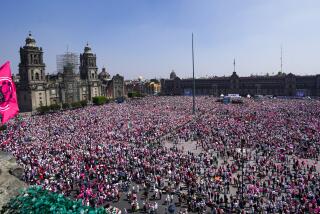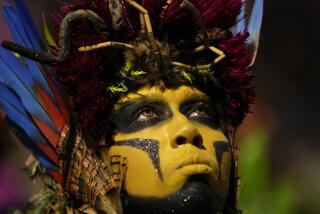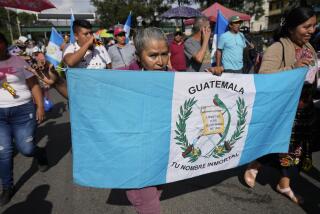Protest Held in Panama City Despite Ban
PANAMA CITY â Despite a new ban on such demonstrations, anti-government protesters again paraded in automobile caravans Wednesday on the streets of Panama City.
There were no signs that Panamanian police or military tried to stop the protests, which were held at noon and in the early evening and were similar to others that have become daily occurrences here. Scattered incidents of violence in the midst of similar caravans late Tuesday apparently prompted the government to call for an end to all such demonstrations.
Opposition leaders said that despite the government prohibition, they were considering holding a massive protest march Friday.
âWe will carry on all forms of peaceful protests to get our demands met,â said Aurelio Barria, president of the Panama Chamber of Commerce, one of several civic organizations that have banded together to seek an end to military dominance of Panamanian politics.
The protests are the most intense and longest-lasting in the 19 years that the military has dominated political life here.
The demonstrations were touched off a month ago when a high-ranking military officer accused Panamaâs strongman, Gen. Manuel A. Noriega, of assassination and corruption and of rigging elections. Noriega, the head of Panamaâs 15,000-member Defense Forces, is widely seen as the power behind the nominal civilian government here.
The staying power of the protests surprises foreign observers here. After a few days of violence in June and a brief state of siege imposed by the government, the protesters regrouped and have staged their auto caravans almost daily ever since.
The government downplays the demands for Noriegaâs removal, calling the protests a phenomenon limited to disgruntled members of the upper class seeking political power. âThis is a protest carried by BMWs, Volvos and Mercedes-Benzes,â said Maj. Edgardo Lopez, Noriegaâs spokesman. âMost Panamanians drive, at most, Volkswagens with bald tires.â
Poor on the Sidelines
Indeed, many protesters appear well-to-do or middle-class. They often gather at U.S.-style shopping centers to begin their cavalcades, looking like fans at a high school football rally, waving white handkerchiefs and honking horns.
Except during the early days of the protests, residents of poor neighborhoods have remained on the sidelines. However, that does not appear to mean they back the government.
Reporters visiting the working-class neighborhood of San Miguelito this week found wide support for the protests. âWe need investigations,â said Arminda Perez, who was getting a manicure at Hildaâs Unisex Salon in San Miguelito. âThis government here is false. It steals elections.â
The endurance of the protests seems to be taking some toll on the unity of the civilian government.
On Wednesday, Vice President Roderick Esquivel criticized his own government for letting the protests get out of hand. âWhen a government cannot manage a country within a framework of law, something is wrong,â Esquivel said.
He blamed the Defense Forces for failing to protect the U.S. Embassy during protests last month, when pro-government demonstrators threw rocks and red paint at the waterfront building. The attack on the embassy followed the passage of a U.S. Senate resolution urging democracy for Panama.
Esquivel claimed that Panamanian President Eric A. Delvalle ordered the embassy protected but was ignored by the military.
Delvalle, the titular head of state, has not been seen publicly since Sunday, when he called for negotiations with the opposition.
There are no signs of splits in the military, considered a key to Noriegaâs future. âThey are tight and disciplined,â said a Western observer. âFor the moment, the troops are standing by Noriega.â
More to Read
Sign up for Essential California
The most important California stories and recommendations in your inbox every morning.
You may occasionally receive promotional content from the Los Angeles Times.










